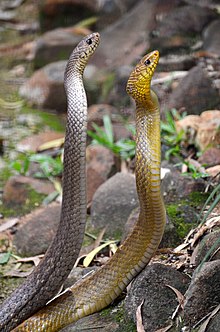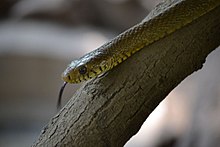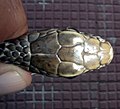Ptyas mucosa
| Ptyas mucosa | |
|---|---|

| |
| Indian rat snakes (grey and yellow) | |
| Scientific classification | |
| Domain: | Eukaryota |
| Kingdom: | Animalia |
| Phylum: | Chordata |
| Class: | Reptilia |
| Order: | Squamata |
| Suborder: | Serpentes |
| Family: | Colubridae |
| Genus: | Ptyas |
| Species: | P. mucosa
|
| Binomial name | |
| Ptyas mucosa | |
| Synonyms[3][2] | |
| |

Ptyas mucosa, commonly known as the Oriental rat snake,[2] dhaman or Indian rat snake,[4] is a common non-venomous species of colubrid snake found in parts of South and Southeast Asia. Dhamans are large snakes. Typical mature total length is around 1.5 to 1.95 m (4 ft 11 in to 6 ft 5 in) though some exceed 2 m (6 ft 7 in). The record length for this species was 3.7 m (12 ft 2 in), second only to their cousin Ptyas carinata among living colubrid snakes.[5][6] Despite their large size, oriental ratsnakes are usually quite slender with even a specimen of 2 m (6 ft 7 in) commonly measuring 4 to 6 cm (1.6 to 2.4 in) only around in diameter[which?].[7] Furthermore, the average weight of ratsnakes caught in Java was around 877 to 940 g (1.933 to 2.072 lb), though larger males of over 2.3 m (7 ft 7 in) (which average mildly larger of the two sexes in the species) may easily weigh over 2.5 kg (5.5 lb).[8] Their color varies from pale browns in dry regions to nearly black in moist forest areas. Rat snakes are diurnal, semi-arboreal, non-venomous, and fast-moving. Rat snakes eat a variety of prey and are frequently found in urban areas where rodents thrive.
Geographic range
[edit]Found in Afghanistan, Bangladesh, Myanmar, Cambodia, China (Zhejiang, Hubei, Jiangxi, Fujian, Guangdong, Hainan, Guangxi, Yunnan, Tibet, Hong Kong), Taiwan, India (including Andaman and Nicobar Islands), Sri Lanka, Indonesia (Sumatra, Java, Bali), Iran, Laos, West Malaysia, Nepal, Myanmar, Pakistan (Sindh area), Thailand, Turkmenistan and Vietnam.[9][10]
Predators
[edit]
Adult rat snakes have no natural predators, although younger specimens are the natural prey of King cobras that overlap them in their range. Juveniles fear birds of prey, larger reptiles, and mid-sized mammals. They are wary, quick to react, and fast-moving.[11]
Rat snakes and related colubrids are aggressively hunted by humans in some areas of their range for skins and meat. Harvesting and trade regulations exist in China and Indonesia, but these regulations are often ignored.[12]
Description
[edit]
Description from Boulenger's Fauna of British India: Reptilia and Batrachia volume of 1890:
Snout obtuse, slightly projecting; eye large; rostral a little broader than deep, visible from above; suture between the internasals shorter than that between the prefrontals; frontal as long as its distance from the end of the snout, as long as the parietals or slightly shorter; usually three loreals; one large preocular, with a small subocular below; two postoculars; temporals 2+2; 8 Upper labials, fourth and fifth entering the eye; 5 Lower labials in contact with the anterior chin shields, which are shorter than the posterior; the latter in contact anteriorly. Dorsal scales in 17 rows at midbody, more or less strongly keeled on the posterior part of the body. Ventrals 190–208; anal divided; subcaudals 95–135, divided. Brown above, frequently with more or less distinct black crossbands on the posterior part of the body and on the tail; young usually with light crossbands on the front half of the body. Lower surface yellowish; the posterior ventral and the caudal shields may be edged with black.[13]
It is the second largest snake in Sri Lanka, after the Indian rock python.
Behavior
[edit]

Rat snakes, though harmless to humans, are fast-moving, excitable snakes. In captivity, they are territorial and may defend their turf aggressively, attempting to startle or strike at passing objects. Rat snakes are diurnal and semi-arboreal. They inhabit forest floors, wetlands, rice paddies, farmland, and suburban areas where they prey upon small reptiles, amphibians, birds, and mammals. Adults, unusually for a colubrid, prefer to subdue their prey by sitting on it rather than by constricting, using body weight to weaken prey.[11][14]
Rat snakes mate in late spring and early summer, though in tropical areas reproduction may take place year round. Males establish boundaries of territory using a ritualised test of strength in which they intertwine their bodies. The behaviour is sometime misread by observers as a "mating dance" between opposite-sex individuals.[14] Females produce 6–15 eggs per clutch several weeks after mating.[11][14]
Adult members of this species emit a growling sound and inflate their necks when threatened. This adaptation may represent mimicry of the king cobra or Indian cobra which overlaps this species in range.[15] The resemblance often backfires in human settlements, though, as the harmless animal may be mistaken for a venomous snake and killed.[11][14]
Nomenclature
[edit]The International Code for Zoological Nomenclature (ICZN) directs that the grammatical gender of any given species name should follow logically from the gender of its associated genus name. As Ptyas is a feminine word form (from πτυάς, a Greek word for a venom-spitting snake), the proper form of the species name is mucosa (a Late Latin word meaning "slimy"). Reference materials older than 2004 often show the masculine form, mucosus, and the CITES list continues to list the species this way.[16][17][18]
Gallery
[edit]-
Head with open mouth
-
Top view of head
-
View of temporals
-
Underside of head
-
Belly of snake
-
Body and scales
-
Body and scales
-
Body and scales
-
Long tail of oriental rat snake
-
Temporals indicated
References
[edit]- ^ Wogan, G.; Srinivasulu, C.; Srinivasulu, B.; Papenfuss, T.; Shafiei Bafti, S.; Orlov, N.L.; Ananjeva, N.B.; Deepak, V.; Borkin, L.; Milto, K.; Golynsky, E.; Rustamov, A, Munkhbayar, K.; Nuridjanov, D.; Dujsebayeva, T.; Shestopal, A.; Sawant, N.S.; Achyuthan, N.S.; Vyas, R.; Shankar, G.; Das, A.; Mohapatra, P.; Thakur, S.; Kulkarni, N.U. (2021). "Ptyas mucosa". IUCN Red List of Threatened Species. 2021: e.T164644A1063584. doi:10.2305/IUCN.UK.2021-3.RLTS.T164644A1063584.en. Retrieved 3 July 2023.
{{cite journal}}: CS1 maint: multiple names: authors list (link) - ^ a b c The Reptile Database:Ptyas mucosa, Reptile-database.org.
- ^ Boulenger, G.A. 1893. Catalogue of the Snakes in the British Museum (Natural History). Volume I., Containing the Families ... Colubridæ Aglyphæ, part. Trustees of the British Museum (Natural History). (Taylor and Francis, Printers). London. xiii + 448 pp. + Plates I.- XXVIII. (Zamenis mucosus, pp. 385–386.)
- ^ Das, I. 2002. A Photographic Guide to Snakes and Other Reptiles of India. Ralph Curtis Books. Sanibel Island, Florida. 144 pp. ISBN 0-88359-056-5. (Ptyas mucosa, p. 43.)
- ^ Auliya, M. (2010). Conservation Status and Impact of Trade on the Oriental Rat Snake Ptyas mucosa in Java, Indonesia. TRAFFIC Southeast Asia.
- ^ Das, I. (2015). A field guide to the reptiles of South-East Asia. Bloomsbury Publishing.
- ^ Nicholson, E. (1893). Indian Snakes: An Elementary Treatise on Ophiology with a Descriptive Catalogue of the Snakes Found in India and the Adjoining Countries. Higgibotham and Company.
- ^ Sabarno, M.Y., Santosa, Y. & Prihadi, N. (2012). Trading System, Abundance and Habitat Characteristic of Oriental Rat-snake Ptyas mucosus (Linnaeus 1758) in Central Java. Bogor Agricultural University.
- ^ "Ptyas mucosa". Reptile-database.reptarium.cz. Retrieved 25 November 2021.
- ^ "Ptyas mucosa". Indiabiodiversity.org. Retrieved 25 November 2021.
- ^ a b c d "Ptyas mucosa - Dhaman (Oriental) Ratsnake". Snakesoftaiwan.com. Archived from the original on 18 November 2019. Retrieved 25 November 2021.
- ^ "traffic_species_reptiles25.pdf" (PDF).
- ^ Boulenger, G.A. (1890). Reptilia and batrachia. The Fauna of British India including Ceylon and Burma. Vol. 1. London: Secretary of State for India in Council. Retrieved 2012-03-13.
- ^ a b c d "Siam-info.com". 77.siam-info.com.
- ^ Young, B.A., Solomon, J., Abishahin, G. 1999. "How many ways can a snake growl? The morphology of sound production in Ptyas mucosus and its potential mimicry of Ophiophagus". Herpetological Journal 9 (3):89–94.
- ^ Auerbach, Paul S. (October 31, 2011). Wilderness Medicine E-Book: Expert Consult Premium Edition - Enhanced Online Features. Elsevier Health Sciences. ISBN 978-1455733569 – via Google Books.
- ^ Roe, Dilys (January 11, 2002). Making a Killing Or Making a Living: Wildlife Trade, Trade Controls, and Rural Livelihoods. IIED. ISBN 9781843692157 – via Google Books.
- ^ "CASE STUDY ON PTYAS MUCOSUS – A PROPOSED NDF METHOD FOR INDONESIA (JAVA)" (PDF). Cites.org. Retrieved 25 November 2021.
Further reading
[edit]- David, P., and I. Das. 2004. On the grammar of the gender of Ptyas Fitzinger, 1843 (Serpentes: Colubridae). Hamaddryad 28 (1 & 2): 113–116.
- Günther, A. 1898. Notes on Indian Snakes in Captivity. Ann. Mag. Nat. Hist., Series 7, 1: 30–31. (Zamenis mucosus, p. 30.)
- Jan, G., & F. Sordelli. 1867. Iconographie générale des Ophidiens: Vingt-quatrième livraison. Baillière. Paris. Index + Plates I.–VI. ("Coryphodon Blumenbachi, Merr.", Plate III., Figures 2–4.)
- Lazell, J.D. 1998. Morphology and the status of the snake genus Ptyas. Herpetological Review 29 (3): 134.
- Linnaeus, C. 1858. Systema naturæ per regna tria naturæ, secundum classes, ordines, genera, species, cum characteribus, differentiis, synonymis, locis. Tomus I. Editio Decima, Reformata. L. Salvius. Stockholm. 824 pp. (Coluber mucosus, p. 226.)
- Morris, P.A. 1948. Boy's Book of Snakes: How to Recognize and Understand Them. A volume of the Humanizing Science Series, edited by Jacques Cattell. Ronald Press. New York. viii + 185 pp. ("The Indian Rat Snake", pp. 136–137, 181.)
- Nixon, A.M.A., and S. Bhupathy. 2001. Notes on the occurrence of Dhaman (Ptyas mucosus) in the higher altitudes of Nilgiris, Western Ghats. Cobra (44): 30–31.
External links
[edit] Media related to Ptyas mucosa at Wikimedia Commons
Media related to Ptyas mucosa at Wikimedia Commons
- IUCN Red List least concern species
- Ptyas
- Reptiles described in 1758
- Reptiles of Afghanistan
- Reptiles of Bangladesh
- Reptiles of Cambodia
- Reptiles of Central Asia
- Reptiles of China
- Reptiles of India
- Reptiles of Indonesia
- Reptiles of Iran
- Reptiles of Laos
- Reptiles of Myanmar
- Reptiles of Nepal
- Reptiles of Pakistan
- Reptiles of Sri Lanka
- Reptiles of Taiwan
- Reptiles of Thailand
- Reptiles of Vietnam
- Snakes of Asia
- Taxa named by Carl Linnaeus










